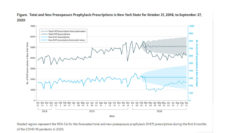Since the 1940s epidemiologists in the United States have analyzed wastewater—the liquid run-off from sinks and toilets that enters sewer systems—to track disease outbreaks. Back then, investigators were using wastewater to track polio. Today we can use wastewater to track an increasing number of viruses, bacteria, and environmental hazards. This ability to track diseases by looking at wastewater became invaluable with the spread of COVID-19.
Researchers and public health officials can now estimate the level of infection of COVID-19 in a city by using wastewater, and by doing this they are quickly able to tell if an outbreak is occurring, even when a large part of the population is asymptomatic. The levels of the COVID-19 virus in wastewater samples accurately mirror the levels of COVID-19 in the community. But what if wastewater could tell us more? To Jana Huisman and her team, wastewater also communicated how contagious the COVID-19 virus was.
The team collected weekly wastewater samples in Zurich, Switzerland from September 2020 to January 2021 and in San Jose, California starting on November 2020 to March 2021. They combined this data with estimate of how long it takes for the COVID-19 virus to be released from our bodies, also known as viral shedding. Using the wastewater samples and the shedding estimates, researchers calculated the contagiousness of COVID-19.
Wastewater could very accurately estimate the how contagious the virus was, and it did it quickly, more cost-effectively, and before clinical symptoms appeared in many persons.
The team also calculated the contagiousness of COVID-19 in these two cities using the more traditional mathematical method, a calculation. This method takes into account three factors: the infectious period of the disease, the mode of transmission, and the contact rate. Problematically, the three factors used to calculate the traditional method vary from person to person. The traditional method is also not considered particularly accurate until symptomatic disease appears, which is often too late to make preventive intervention.
Huisman’s team compared the results of the wastewater method to the results from the traditional mathematical method, and found that the difference between them was minimal. Wastewater could very accurately estimate the how contagious the virus was, and it did it quickly, more cost-effectively, and before clinical symptoms appeared in many persons.
The authors argue that this method of calculating how contagious a virus is can be used for other diseases. If we know how long the pathogen stays in the body, we can now estimate how contagious it is by looking at wastewater.
Health departments continue to use wastewater to track the spread of COVID-19. We even have dashboards that tell us virus levels in wastewater in our communities. And with a new way to estimate the level of contagiousness of a virus, we might be even better prepared to predict future outbreaks of COVID-19 and other illnesses.
Photo via Getty Images














